Natural Gold Ores and
Minerals |
|
|
Gold and silver are obtained from a
variety of ores. Most people think of nuggets and such, but the truth is that
very little comes from nuggets - nearly all newly mined gold comes from ores
mined from the natural hard rocks that contain gold in tiny, even microscopic
particles. This webpage is created to show what some of those ores look like.
Gold is found widely diffused in nature even though it is one of the scarcer
metals. Very commonly, gold occurs as the native metal encased within quartz.
Sometimes the gold is in a finely divided state, sometimes in particles of
considerable size, as nuggets, grains, scales, plates, threads and wires in
quartz rock. It occurs also in a finely divided state disseminated through
schistose rocks, slates and some sedimentary rocks like limestone. In these
cases the rock has been altered by the flow of heated and mineralized waters,
often resulting in the impregnation of large amounts of rock with silica and
iron. Sometimes the silicified rock even replaces the original country rock.
While historically speaking vein deposits were the most productive, these
disseminated deposits currently yield much of the worlds gold ore. Within gold ores, the element occurs
in nature chiefly as native gold, which is by far the most common gold bearing
mineral. In various gold ores, the native gold commonly occurs as tiny particles
contained within sulfide minerals such as pyrite. Iron pyrite is an exceedingly
common associate with gold, but it also serves as a reducing agent. Therefore
whenever gold is found encased in pyrite, it is always present as free gold and
not as some type of gold sulphide. Gold is also found at times in chalcopyrite,
galena and
arsenopyrite and
stibnite, but not as a rule in such large amounts as
may be found in pyrite. Other minerals, like
sphalerite, pyrrhotite,
magnetite
and
hematite sometimes carry small amounts of gold as well. Gold also occurs as tellurides such as calaverite. Common gangue minerals in gold ores include
quartz,
fluorite,
calcite and pyrite, but many others can be found in smaller
amounts. |
|
 |
This piece of gold ore does not look very spectacular, but millions of tons
of this material have revolutionized gold mining across the world. It is a
sediment hosted bulk gold deposit.
This gold ore is typical of a great series of deposits extending north and south from near
Carlin,
Nevada have yielded millions of ounces of gold. Over the last 50 years, this
district has become the most productive gold district in the US, producing
over 60 million ounces of gold to date. The ore consists of silicified rock
that often was originally some sort of limy shale. In some places the silicification is sufficient that the rock is known as jasperiod. Much
of the material is low grade, but there is some material is high (over an
ounce per ton) in grade. Barrick and Newmont control the most important
properties in the area. |
|
|
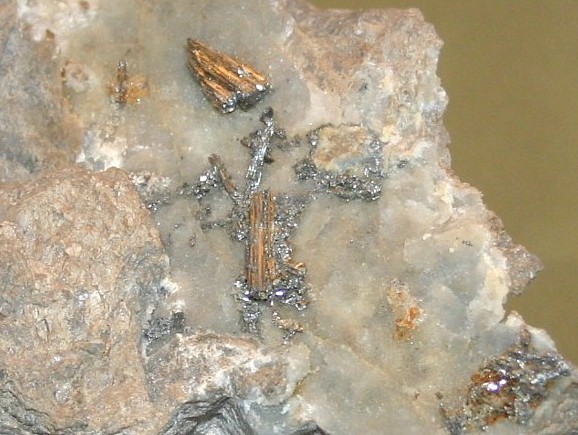 |
These
are crystals of Calaverite - a gold, silver and tellurium mineral. This is very high
grade gold ore from the Cripple Creek district in Colorado. Many old
time miners mistook this type of mineral for low grade sulfides, but this
silvery metallic material probably is 40 percent gold by weight.
Tellurides are often associated with rich ore - and that was true at Cripple
Creek as it was elsewhere.
|
|
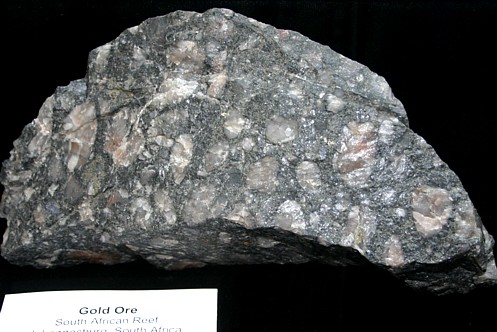 |
This is a piece of gold
ore from the famous Witwatersrand gold deposits of South Africa. The ore
consists of conglomerate pebbles mostly of quartz, in a sandy matrix, with abundant
pyrite in the cement. The gold, which occurs in the cement but not in the
pebbles, is closely connected with the pyrite and is not visible to the
naked eye. It is generally agreed that this auriferous
conglomerate represents an ancient placer, although the gold and pyrite have
been re-disolved and moved around or recrystalized after emplacement. Most geologists
see these ores as fossilized placer deposits altered by heat and water flows.
The auriferous
conglomerates of the Johannesburg district of South Africa, are of
apparently simple structure. The Witwatersrand system consists of slates, quartzites,
and conglomerates, aggregating 19,000 feet in thickness, which are overlain in
turn by the Ventersdorp system of volcanics. The Witwatersrand, which is
probably of Cambrian or pre-Cambrian age, forms a syncline with Johannesburg
on its north side. The series has been faulted and also cut by diabase
dikes, and while gold bearing conglomerates are found at several different
horizons, the most productive ones are in the upper part. |
|
|
|
|
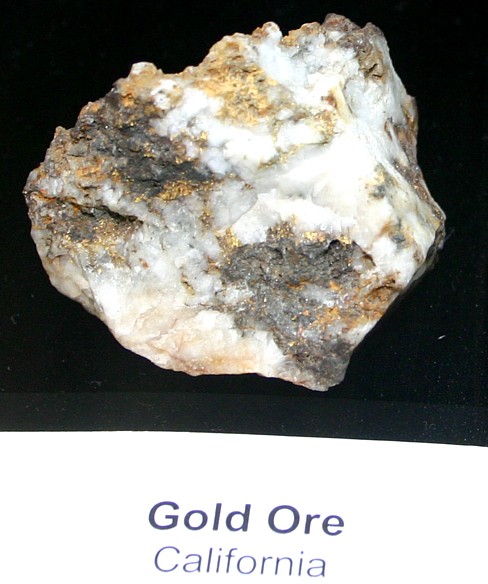 |
Small
bits of gold are scattered through this piece of mesothermal vein quartz from
the mother lode region of California. The gold is mostly concentrated around the edges of dark colored
spots of iron oxide that were likely originally clots of pyrite. This is very rich gold
ore. |
|
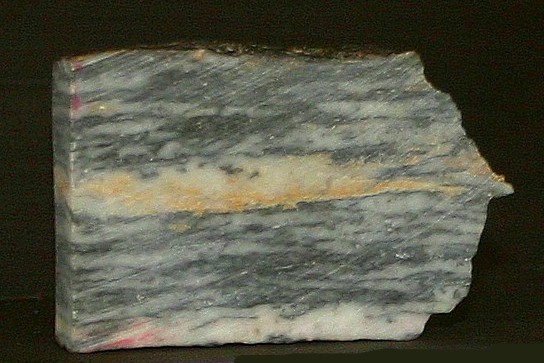 |
This small but rich specimen slab is from a narrow quartz vein found in
Russia. Native gold runs down the center line. |
|
|
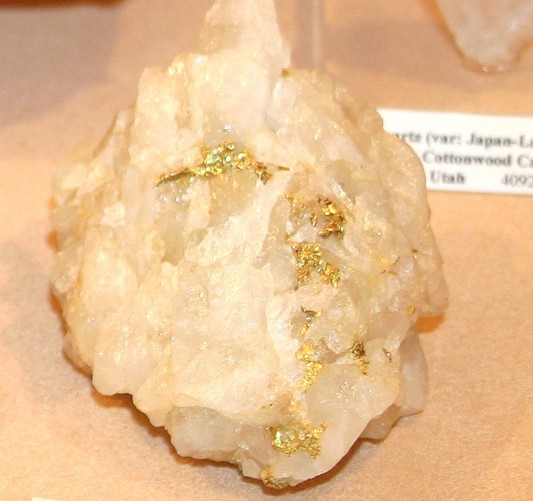 |
Most
gold contained in quartz veins is in tiny particles that are not always easy
to see in the rock. This ore shows considerable bright and visible metallic
gold disbursed through the quartz vein gold ore. |
|
|
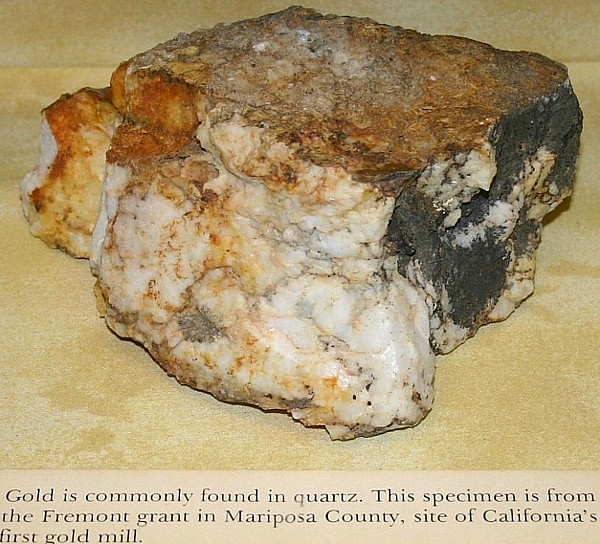 |
This
chunk of vein quartz from Mariposa is typical of gold-quartz material from
the mother lode district of California. In most gold ore, the gold is
present in tiny specs, either within minerals like pyrite, or spread out
free among the quartz. Normally even good, rich gold ore has no gold metal
which is visible to the naked eye. |
|
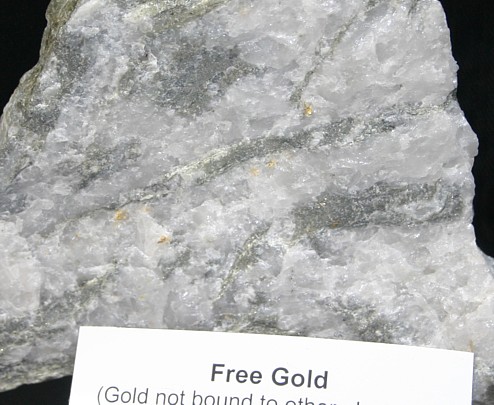 |
The photo
at left shows small particles of metallic gold in quartz taken from the
mountains of Canada. Sections of gray colored quartz in the specimen have this
appearance because of the finely disbursed sulfide crystals present in this
ore. |
|
|
|
|
|
 |
The
mining district of Austin, in central Nevada was well known for its silver
ores, but this specimen of oxidized ore also contains a considerable amount
of gold in addition to the silver. It shows few sulfide minerals because it
is well oxidized. |
|
|
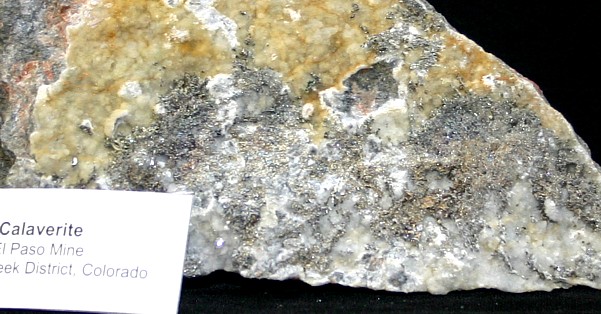 |
Gold
does not commonly combine with other elements, but there are exceptions.
These are the telluride minerals such as Calaverite. This very rich gold ore
specimen came from the El Paso gold mine in the Cripple Creek district in Colorado. |
|
|
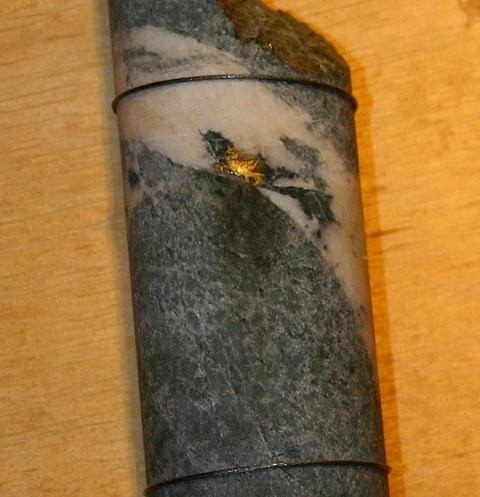 |
Here is a small gold-quartz stringer that was cut through by a core drill
during exploration. This core shows coarse crystalline gold near the wall of
the small veinlet. This specimen was drilled at the
Kensington mine property in Alaska. |
|
|
. |
|
Recommended
Metal Detectors
For Gold Prospecting:
|
|
 |
Here
is yet another beautiful gold piece from the big mine at Round Mountain. The
gold is formed in a mossy crystalline pattern on the surface of the rock.
The bulk of the ore which comes from his mine, produces gold only in tiny
microscopic particles. Only a very small percentage of the gold occurs in
visible pieces like this. |
|
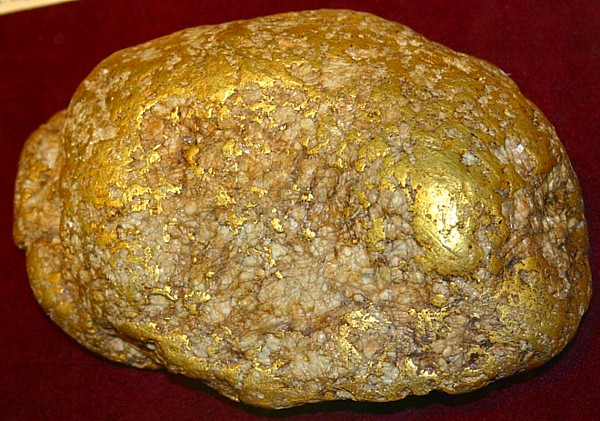 |
This
very large nugget gold specimen contains significant quartz and is from Alaska.
It's rounded shape shows the signs of wear
and tumbling in a river environment. |
|
|
|
Gold Ore Minerals:
The most prominent is native gold - most of
the native gold contains a small amount of
silver,
copper,
platinum, etc.
Telluride minerals are the most common minerals which contain significant gold
in their make up. They include: Petzite (Ag,Au) 2,Te, with a gold content of
about 25 per cent. Hessite (Ag2Te), with gold often present replacing a part of
the silver.
Sylvanite
(Au,Ag)Te2 : typically about 25 per cent. gold.
Calaverite
(Au,Ag)Te2 : typically about 40 per cent, gold. Krennerite (Ag2Te,Au2Te3) : gold
is about 35 percent. Nagyagite (Au2,Pbi4,Sb3,Te7,S7). Some samples of Nagyagite
have given upon analysis 12.75 per cent gold. The gold containing sulphides, as
well as the tellurides, are of primary formation, although auriferous
chalcopyrite might also be formed by secondary enrichment processes. Native gold
may occur in the primary, secondary enrichment, or oxidized zones. The
tellurides, which are usually associated with pyrite, are widely distributed,
though not so abundant, but not always recognized; indeed by some miners they
are mistaken for sulfides. For more information see:
minerals associated with gold ores.
General Types of Gold Ores:
Gold deposits are often classified according to
their association. The first of these may be catalogued as quartzose. This
implies that the gangue mineral is acid, that is,
quartz,
and that fluorite may abound, or even the other gangue minerals of the alkaline
earth group. Not infrequently there appears within the quartz varying amounts of
pyrite
and even limited quantities of
,chalcopyrite
and
galena.
These are free milling ores. By a free milling ore is meant one that does not
require roasting before amalgamation will take place. Dry ore is the term often
used. The second class of gold ores is auriferous copper ores. These are widely
distributed throughout the United States and much of the chalcopyrite is gold
bearing. These auriferous copper ores are especially abundant in Colorado, Utah,
Montana and British Columbia. Also at Gold Hill, North Carolina and in
Newfoundland. The third class of gold ore is auriferous lead ores. The
percentage of lead is large and the gold content often small. They are
refractory ores like the copper ores. By refractory ore is meant one that
requires roasting before amalgamation will take place. The heavy
sulfides as copper, lead and antimony require this method of
treatment, that is the condition of the gold in the mineral will not allow of
its immediate union with mercury upon the amalgamation plates. The fourth class
of gold ores comprises the gold-telluride group. The gold telluride ores occur
with silver, or with silver, lead and antimony, or as native gold accompanied by
other tellurides. These ores are often sent direct to the smelters for
treatment. A fifth type is the disseminated ore type. They are often low in
grade but large. They fill large fracture and fault zones or replace certain
geologic horizons. They are the result of the circulation of large amounts of
heated water deep underground.
Character of Gold Ore
Bodies:
A very common occurrence of gold ore is in
true fissure veins, even and perhaps more abundant, in seams or layers in close
proximity to the hanging wall, occasionally migrating across the fissure vein
and then in close proximity to the footwall. Fissure veins often fluctuate
greatly in value, so that the ore richest in gold occurs in pockets, or
"bonanzas" as the miner says. In some mining belts one may by systematic
drifting along the direction of the main fissure vein encounter a gold ore
"bonanza." Where the normal concentration or value through the vein might be
less than a quarter ounce of gold per ton of ore, a pocket might be represented by a ore with a
richness of more than 1000 ounces per ton. It often occurs that drifting
along the line of the vein must be carried for thousands of feet in low grade
ore that does not pay for the extraction of the metal before such a pocket of
gold ore is encountered. Again, the line carrying the gold may be simply a thin
seam or film, so that all the gold ore workable with profit may be deposited
from solution on a film so thin as to be almost invisible to the naked eye.
Sometimes the material of the entire vein is rich enough to pay for the
profitable extraction of the metal. This is especially true in some gold mines
of British Columbia and Alaska. The ores are more likely to be spotted than
otherwise, that is, gold occurs in small pockets rather than with a uniform
distribution throughout the entire vein. The vast majority of gold deposits
within the United States occur in true fissure veins, and while these were
historically the most important sources, only a few are still worked. The
second type is known as the propylitic in which through the metasomatic
alterations of the wall rock there is developed secondary minerals such as
chlorite and epidote, the former resulting from the metamorphism of various
micas, the latter from the alterations of feldspars. These propylitic types are
in close proximity to veins of sericite and kaolin. The first type occurring
with quartz gangue in true fissure veins is seldom highly argentiferous, the
second type in which kaolinization has taken place is often rich in silver
content or highly silver-bearing. The character of the rock which the vein
traverses is often variable, for the gold-bearing veins appear in either igneous
or sedimentary rocks, sometimes at the contact zone between igneous and
sedimentary rocks, little influenced by the character of the rock which the vein
traverses save in the case of replacement. Again, true fissure veins, in the
more recent lava flows, often appear intimately associated with tellurium, and
these often give rise to ore pockets of great richness. In the telluride group
the ores occur either as definite tellurides of gold with silver, lead and
antimony, or as native gold accompanied with various tellurides. The gangue
minerals are quartz and fluorite; calcite may be sparingly present. In Boulder
County, Colorado, roscoelite, a vanadium mica, is associated with the tellurides.
If you haven't seen my
original crystal nugget page, beautiful nugget photos:
CRYSTAL GOLD NUGGETS
A second page of
beautiful nugget photos:
GOLD AND PLATINUM NUGGETS
I also have a page of
beautiful Silver Ore Specimen photos:
SILVER ORES AND MINERALS
For more information on
gold vein ores, check out my page of
CALIFORNIA MOTHER LODE GOLD QUARTZ VEINS
To learn about the
minerals that produce copper, check my page of
COPPER ORES AND MINERALS
Please note these
specimens are not for sale, most are not owned by me. I present this page as a
reference, as folks just love to look at real natural beauty and these gold
specimens are definitely that.
Photographs and text are copyrighted and may not be reproduced
without permission.
Gold Nugget, Gold Fever, Gold Prospecting, Gold
Panning, Gold detecting, gold flakes, gold dust, gold jewelry, gold crystals,
gold bullion, gold coins, gold bars, gold mine, gold digger













